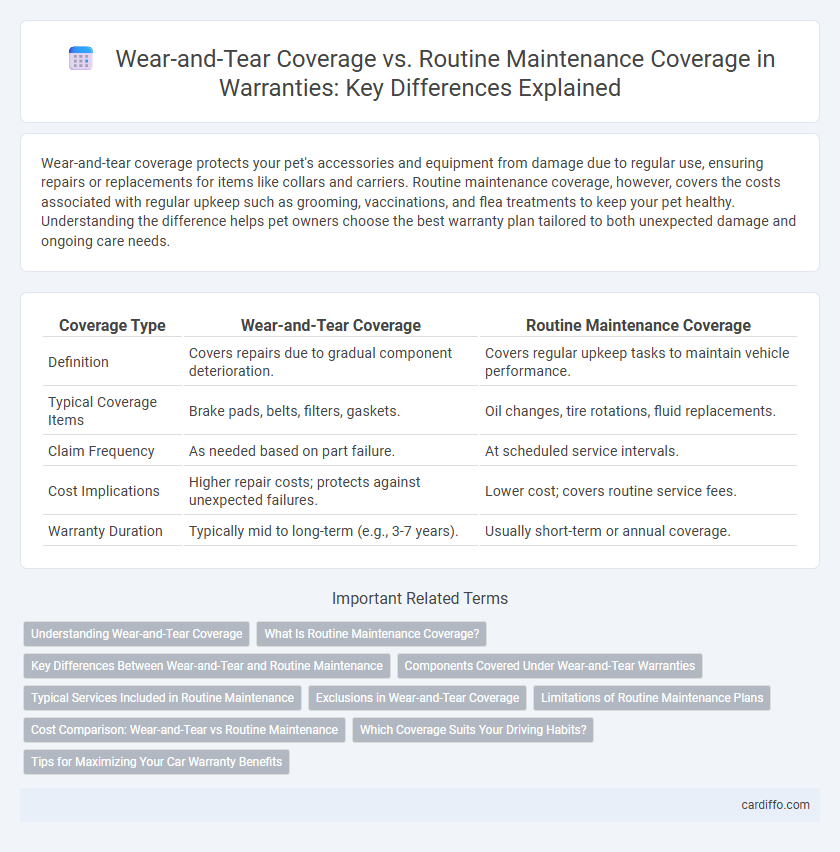Wear-and-tear coverage protects your pet's accessories and equipment from damage due to regular use, ensuring repairs or replacements for items like collars and carriers. Routine maintenance coverage, however, covers the costs associated with regular upkeep such as grooming, vaccinations, and flea treatments to keep your pet healthy. Understanding the difference helps pet owners choose the best warranty plan tailored to both unexpected damage and ongoing care needs.
Table of Comparison
| Coverage Type | Wear-and-Tear Coverage | Routine Maintenance Coverage |
|---|---|---|
| Definition | Covers repairs due to gradual component deterioration. | Covers regular upkeep tasks to maintain vehicle performance. |
| Typical Coverage Items | Brake pads, belts, filters, gaskets. | Oil changes, tire rotations, fluid replacements. |
| Claim Frequency | As needed based on part failure. | At scheduled service intervals. |
| Cost Implications | Higher repair costs; protects against unexpected failures. | Lower cost; covers routine service fees. |
| Warranty Duration | Typically mid to long-term (e.g., 3-7 years). | Usually short-term or annual coverage. |
Understanding Wear-and-Tear Coverage
Wear-and-tear coverage protects against the gradual deterioration of vehicle components due to normal use, addressing issues like worn brake pads, tires, and engine belts. This type of warranty ensures repairs or replacements for parts that fail from everyday use, excluding damage from accidents or neglect. Understanding wear-and-tear coverage helps vehicle owners budget for essential repairs while distinguishing it from routine maintenance, which includes scheduled services like oil changes and inspections.
What Is Routine Maintenance Coverage?
Routine maintenance coverage refers to insurance or warranty plans that cover the costs of regular, scheduled services necessary to keep a product or vehicle operating efficiently, such as oil changes, tire rotations, and brake inspections. This type of coverage ensures that essential upkeep tasks are performed without additional out-of-pocket expenses, helping to prevent breakdowns and extend the lifespan of the item. Routine maintenance is distinct from wear-and-tear coverage, which addresses the repair or replacement of parts that degrade over time due to normal use.
Key Differences Between Wear-and-Tear and Routine Maintenance
Wear-and-tear coverage protects against gradual deterioration of vehicle components due to regular usage, such as brake pads, tires, and suspension parts. Routine maintenance coverage includes scheduled services like oil changes, fluid top-ups, and filter replacements required to keep the vehicle operating efficiently. The key difference lies in wear-and-tear addressing parts failing from normal use, while routine maintenance involves preventive care to avoid breakdowns.
Components Covered Under Wear-and-Tear Warranties
Wear-and-tear warranties primarily cover essential vehicle components subject to degradation from regular use, such as the engine, transmission, suspension, and braking systems. These warranties exclude routine maintenance items like oil changes, brake pads, and tire rotations that are expected to be serviced regularly. Understanding the distinction helps vehicle owners avoid unexpected repair costs by identifying which mechanical failures are covered under wear-and-tear protection.
Typical Services Included in Routine Maintenance
Routine maintenance coverage typically includes essential services like oil changes, tire rotations, brake pad inspections, and air filter replacements, which are crucial for sustaining vehicle performance and longevity. These services are designed to prevent wear-and-tear issues by addressing common maintenance needs at regular intervals specified by the vehicle manufacturer. Wear-and-tear coverage, in contrast, focuses on repairing or replacing parts that deteriorate over time due to normal use, rather than scheduled upkeep tasks.
Exclusions in Wear-and-Tear Coverage
Wear-and-tear coverage excludes damages caused by neglect, accidents, or improper use, focusing solely on natural deterioration of parts due to normal usage. Routine maintenance tasks such as oil changes, brake pad replacements, and fluid top-ups are explicitly excluded from wear-and-tear plans. These exclusions ensure that coverage remains limited to specific mechanical wear rather than general upkeep or preventable damage.
Limitations of Routine Maintenance Plans
Routine maintenance coverage typically excludes repairs related to wear-and-tear, focusing only on scheduled services such as oil changes and filter replacements. These plans often have strict limitations, excluding coverage for parts prone to gradual deterioration or damage from normal use. Understanding these restrictions is essential for vehicle owners seeking comprehensive protection beyond routine upkeep.
Cost Comparison: Wear-and-Tear vs Routine Maintenance
Wear-and-tear coverage typically involves higher upfront costs due to covering parts prone to gradual deterioration, such as brakes and suspension components, whereas routine maintenance coverage usually incurs lower fees by focusing on scheduled services like oil changes and tire rotations. Repair expenses under wear-and-tear coverage can be substantial but are often unpredictable, while routine maintenance costs remain more consistent and manageable over time. Understanding these financial differences helps consumers select warranty plans that align with their budget and vehicle usage patterns.
Which Coverage Suits Your Driving Habits?
Wear-and-tear coverage is ideal for drivers who frequently use their vehicle for long distances or in harsh conditions, as it protects against gradual component deterioration. Routine maintenance coverage suits those who prefer scheduled services such as oil changes, tire rotations, and brake inspections to keep the car running smoothly. Assess your driving habits and vehicle usage to determine which coverage aligns best with your needs, ensuring optimal protection and cost-efficiency.
Tips for Maximizing Your Car Warranty Benefits
Maximizing your car warranty benefits involves understanding the distinction between wear-and-tear coverage and routine maintenance coverage, as wear-and-tear covers unexpected parts failure while routine maintenance includes scheduled services like oil changes. Keep detailed service records and adhere to the manufacturer's maintenance schedule to ensure coverage eligibility and avoid denied claims. Utilize authorized service centers for repairs and inspections to maintain warranty validity and maximize long-term protection for your vehicle.
Wear-and-Tear Coverage vs Routine Maintenance Coverage Infographic

 cardiffo.com
cardiffo.com